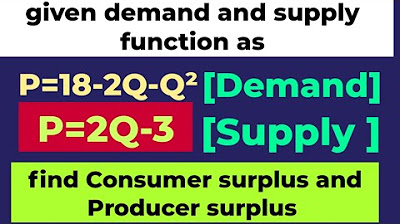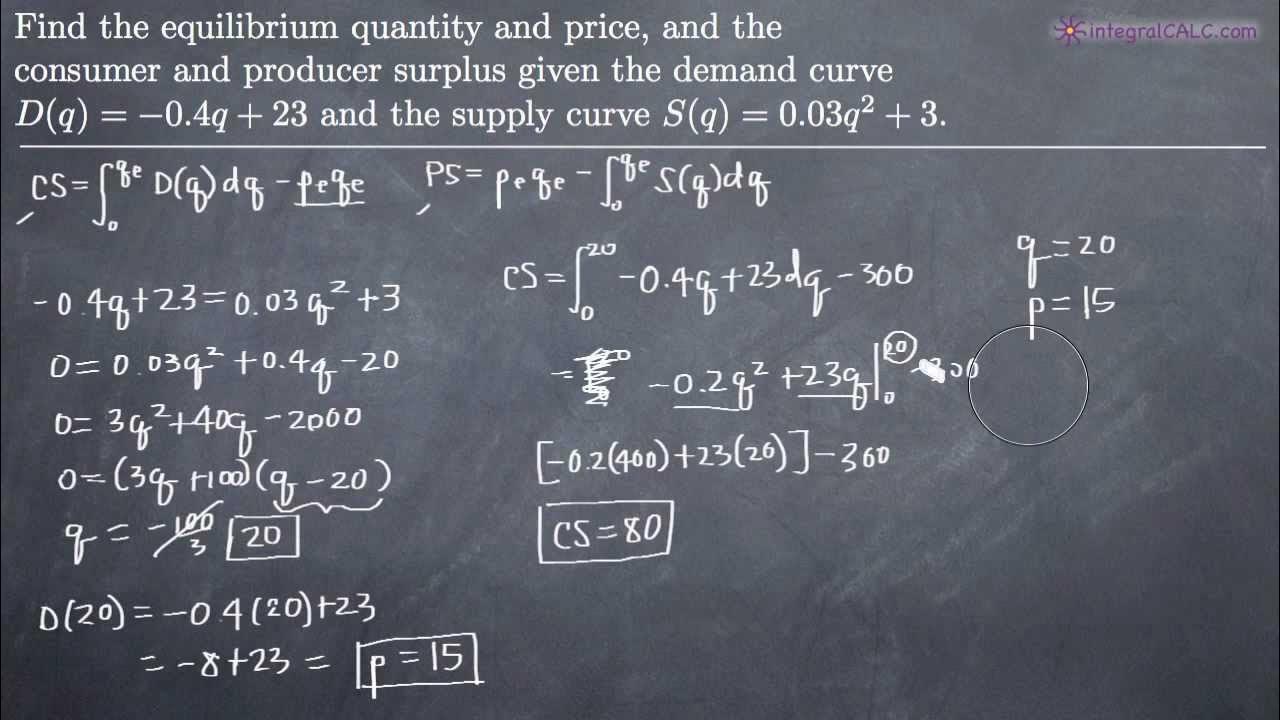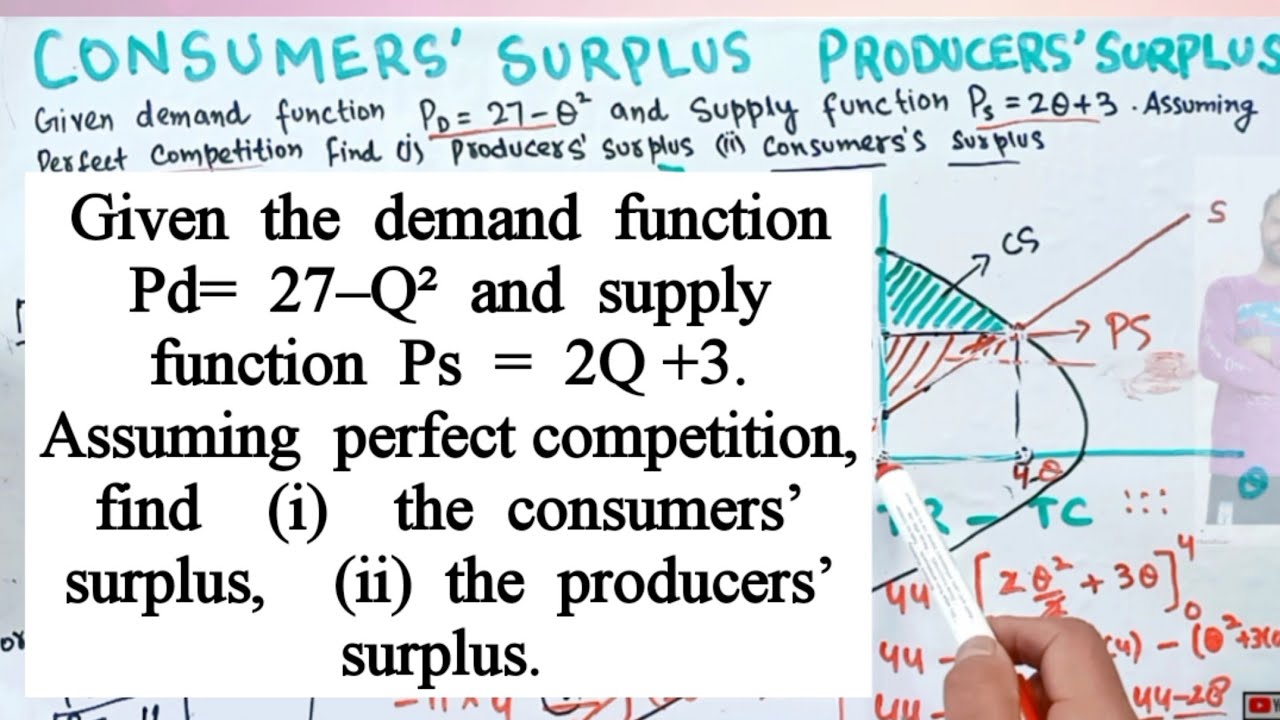Consumer-Producer Surplus (p. 476 #10 )
TLDRThis video script explains the process of calculating consumer and producer surplus using demand and supply functions. It demonstrates how to find equilibrium price and quantity by setting the supply and demand equations equal to each other and solving the resulting quadratic equation. The script then uses these values to compute the surpluses through definite integrals, providing step-by-step instructions and examples, including the use of technology for calculations.
Takeaways
- 📚 The key to solving economic problems involving consumer and producer surplus is understanding and applying definite integrals with demand and supply functions.
- 🔍 To calculate consumer surplus, one must use the demand function, while producer surplus is calculated using the supply function, both requiring equilibrium price (P bar) and quantity (X bar).
- 🔑 The equilibrium price and quantity are found by setting the demand and supply functions equal to each other and solving the resulting equation.
- 📉 The demand function for Titan tire company's super titan tires is given as P = 48 + (1/2)x^2, where P is in dollars and x is in thousands of units.
- 📈 The supply function is P = 144 - x^2, which is used to determine the producer surplus when combined with the equilibrium price and quantity.
- 🧩 To find the equilibrium price and quantity, rearrange the supply and demand equations to form a quadratic equation, solve for x, and then find the corresponding P value.
- ❌ Negative values for quantity are discarded as they do not make sense in the context of production and supply.
- 🔢 The consumer surplus is calculated by integrating the demand function from 0 to the equilibrium quantity (X bar) and then subtracting the area under the price line from 0 to X bar.
- 📊 The producer surplus is similarly calculated by integrating the supply function from 0 to X bar and subtracting the area under the price line.
- 💰 The final values for consumer and producer surplus must be adjusted according to the units used in the problem, in this case, multiplying by a thousand.
- 📝 For complex calculations, technology such as online tools like GeoGebra or graphing calculators can be used, but traditional methods using antiderivatives are also valid.
Q & A
What is the purpose of the 'D of X' mentioned in the script?
-The 'D of X' refers to the demand function, which is used to calculate consumer surplus in economic analysis.
What are the key values needed to calculate consumer and producer surplus?
-The key values needed are P bar (equilibrium price) and X bar (equilibrium quantity).
How is the equilibrium price determined in the context of this script?
-The equilibrium price is determined by setting the supply and demand functions equal to each other and solving for the price where they intersect.
Provide your answer here
-null
Outlines
📚 Calculating Consumer and Producer Surplus
This paragraph introduces the concept of calculating consumer and producer surplus using definite integrals. It emphasizes the importance of the demand and supply functions, as well as the equilibrium price (P bar) and quantity (X bar). The speaker explains the process of finding the equilibrium by setting the demand and supply functions equal to each other, solving for X, and then finding P. The example of the Titan tire company is used to illustrate the process, with the demand function given as P = 48 + 0.5x^2 and the supply function as P = 144 - x^2. The equilibrium price and quantity are calculated, resulting in X bar = 8 and P bar = 80.
📈 Detailed Calculation of Consumer and Producer Surplus
The second paragraph delves into the detailed calculations of consumer and producer surplus for the Titan tire company example. The consumer surplus is calculated using the demand function and the equilibrium values of X and P, with the definite integral evaluated from 0 to X bar. The result is then multiplied by a thousand to match the units of the problem. The producer surplus is calculated similarly, but using the supply function. Both surpluses are presented in monetary units, with the consumer surplus being $341,333.33 and the producer surplus being $170,666.67. The paragraph concludes with a summary of the strategy for calculating surpluses, which involves finding equilibrium price and quantity, and then applying them to the respective surplus formulas.
Mindmap
Keywords
💡Definite Integrals
💡Demand Function
💡Consumer Surplus
💡Supply Function
💡Producer Surplus
💡Equilibrium Price
💡Equilibrium Quantity
💡Quadratic Equation
💡Antiderivative
💡GeoGebra
💡Graphing Calculator
Highlights
The key to solving economic problems involving consumer and producer surplus is understanding definite integrals and the use of demand and supply functions.
Consumer surplus is calculated using the demand function, while producer surplus uses the supply function, both requiring equilibrium price (P bar) and quantity (X bar).
To find equilibrium price and quantity, set the supply and demand equations equal to each other and solve the resulting quadratic equation.
The demand function for Titan tire company's super titan tires is given as a relation between quantity demanded and unit price, with P in dollars and X in thousands of units.
The supply function for the tires is expressed in terms of unit price depending on the quantity supplied, crucial for calculating producer surplus.
Equilibrium price and quantity are determined by solving the supply and demand equations, which simplifies to a quadratic equation.
After rearranging terms, the solution involves adding X squared to both sides and subtracting 48, then solving for X by taking the square root.
The equilibrium quantity X bar is determined by rejecting negative values, resulting in X bar being set to 8 for the tires example.
To find the equilibrium price P bar, substitute the value of X bar into either the supply or demand equation.
The consumer surplus formula involves plugging in the equilibrium values and using the definite integral calculated with technology or traditional methods.
The definite integral for consumer surplus is evaluated between zero and the equilibrium quantity, with the result adjusted for the price.
The consumer surplus is calculated as 341.33 repeating, which, when multiplied by a thousand due to units, results in 341,333.33 cents.
For producer surplus, the process is similar but uses the supply function, with the integral evaluated from 0 to the equilibrium quantity.
The producer surplus calculation involves subtracting the integral result from the product of equilibrium price and quantity.
The final producer surplus is 170,066.67 cents, rounded to the nearest cent, after adjusting for units of a thousand.
The strategy for calculating both consumer and producer surplus involves finding equilibrium P and X, then applying them to respective surplus formulas.
The importance of correctly setting up and solving the supply and demand equations for accurate surplus calculations is emphasized.
The use of technology, such as Geogebra or graphing calculators, is recommended for calculating definite integrals in surplus formulas.
Transcripts
Browse More Related Video

consumer surplus and producer surplus

Consumers' Surplus , Producers' Surplus & Total Surplus from demand & supply Functions #PS

How to Calculate Producer Surplus and Consumer Surplus from Supply and Demand Equations | Think Econ

Consumer and Producer Surplus (KristaKingMath)

Consumers 'surplus Producers' Surplus , Total surplus, deadweight loss with price floor

Consumers' Surplus Producers' Surplus from given Demand and Supply functions
5.0 / 5 (0 votes)
Thanks for rating: